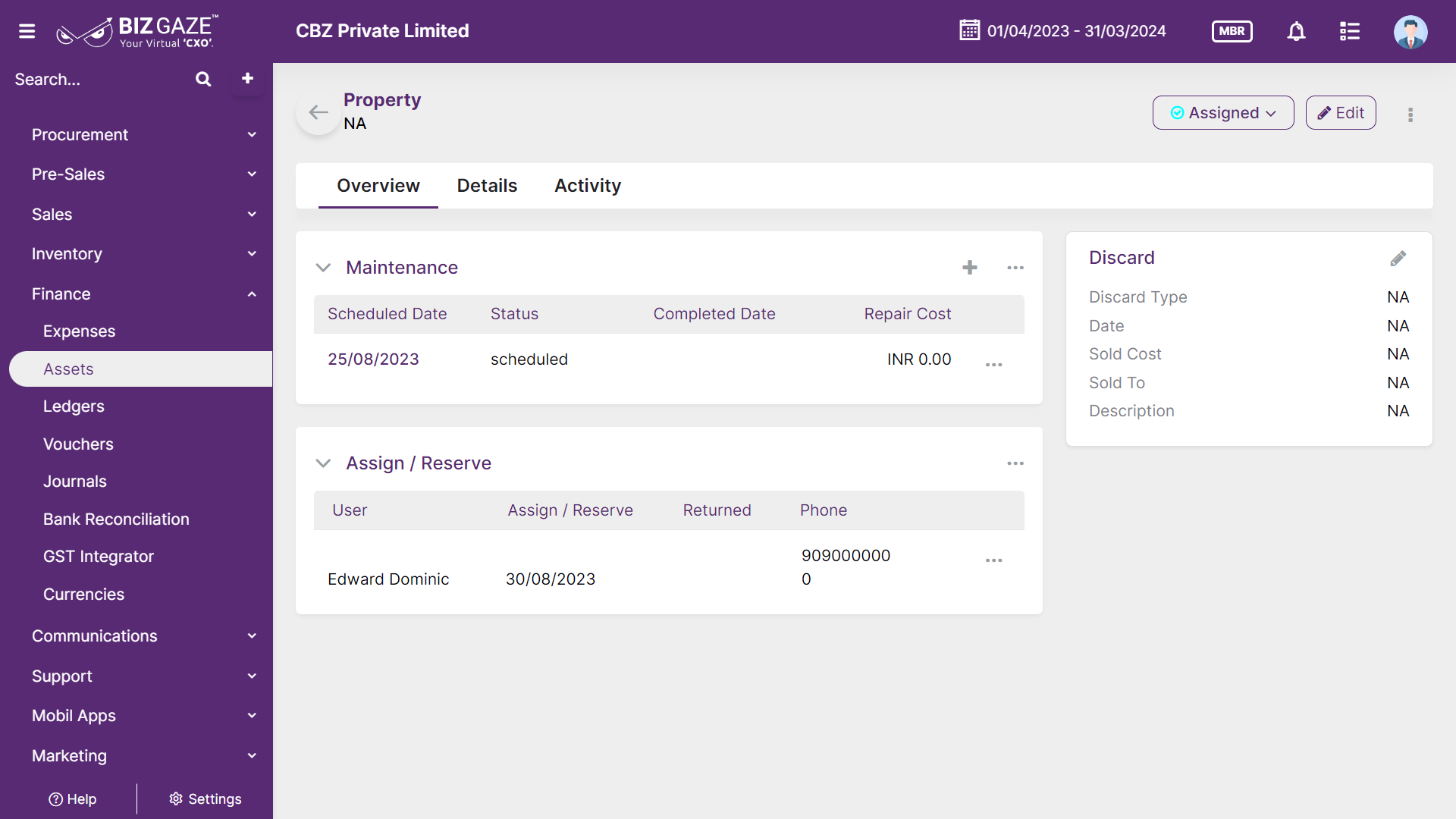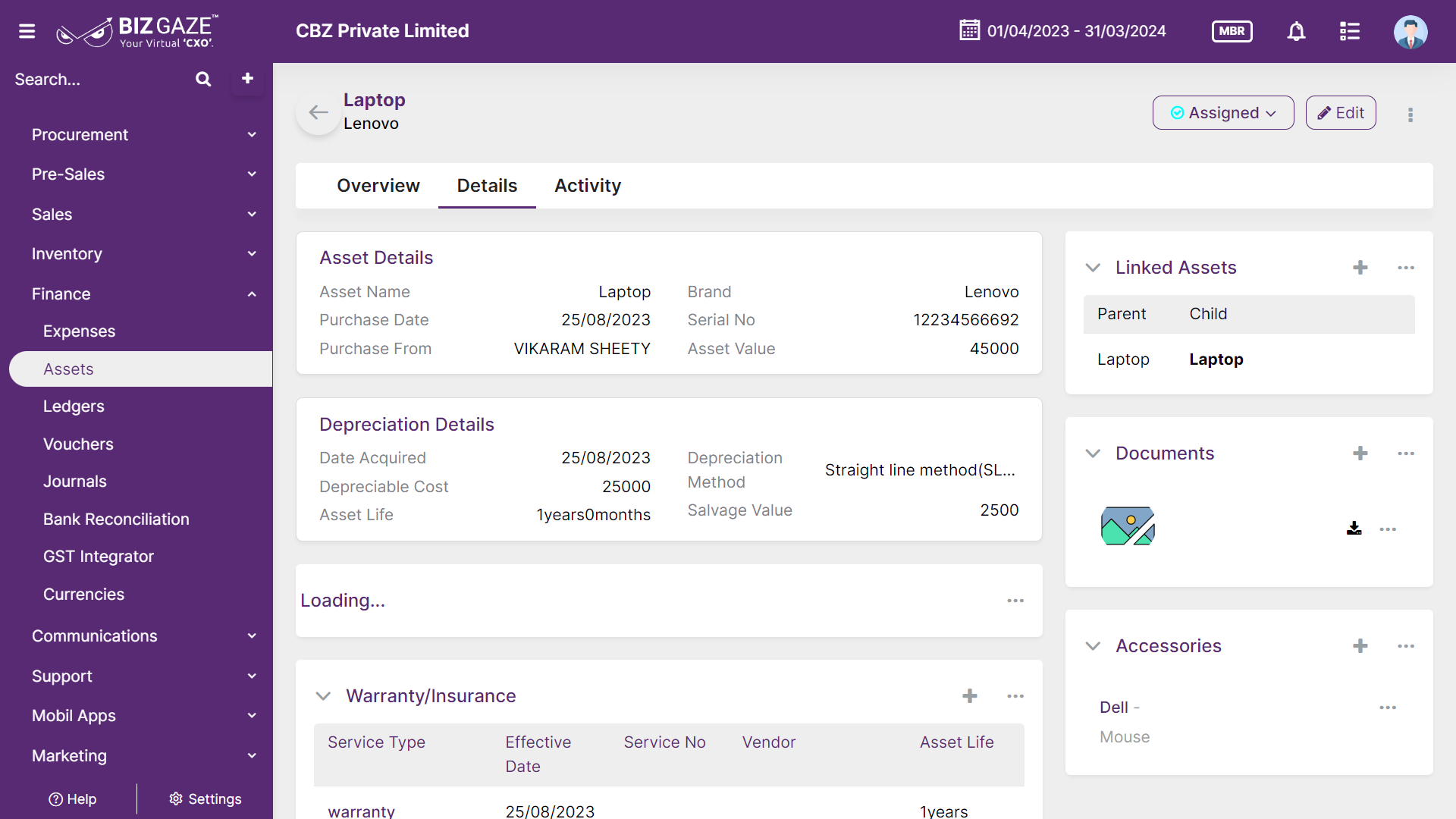Introduction
Assets refer to tangible or intangible resources that hold economic value and are owned or controlled by the business entity. Assets are the valuable resources that a business uses to generate income, provide products or services, and support its operations.
BizGaze’s “Assets App” streamlines asset management processes, enhance data accuracy, improve operational efficiency, and enable effective decision-making related to assets. They provide a centralized platform for businesses to efficiently manage their assets, leading to cost savings, increased productivity, and better utilization of resources.
Stage Workflow
| Field Name | Description |
| All | The data of all Assets will be displayed here |
| Available | Assets that are ready to be assigned or used |
| Assigned | Assets that have been allocated or assigned to specific individuals or departments |
| Maintenance | Assets that are undergoing maintenance or repairs to ensure their optimal functioning |
| Discard | Assets that are no longer usable and are scheduled for disposal or removal from the organization’s inventory |
Portlets & Widgets
In the layout view, a Portlet accurately represents each functionality, and its corresponding data is precisely viewed as a Widget. The following section includes the default portlets and widgets of the Assets App.
Maintenance
This widget contains the maintenance details of the asset like scheduled date, repair cost and status of the maintenance frequency
| Field name | Description |
| Scheduled Date | The scheduled maintenance date of the asset is displayed |
| Status | Displays whether the maintenance is completed or not |
| Completed Date | The date on which the maintenance is completed |
| Repair Cost | The cost occurred for the maintenance (repair) of the asset |
Assign / Reserve
This widget contains the user details and date of the assign and reservation of the asset
| Field name | Description |
| User | Displays the employee name or user name to whom the asset is assigned/reserved |
| Assign/Reserve | Displays the date when the asset is assigned/reserved |
| Returned Date | Displays the date when the asset is returned |
| Phone | Phone number of the user to whom the asset is assigned/reserved |
Discard
This widget contains the discard details of the asset. Discard signifies that the asset is no longer needed, functional, or economically viable for the business.
| Field name | Description |
| Discard Type | Discard type of the asset is displayed. Discard Type categorizes the reason or method for discarding an asset. It provides information about the specific type of disposal, such as sale, donation, scrapping, or write-off. |
| Date | Displays the asset discard date. The date represents the specific day, month, and year associated with a particular event or transaction related to the asset. It can refer to the date of acquisition, discard, sale, or any other relevant activity related to the asset. |
| Sold Cost | Sold Cost represents the amount at which an asset is sold. It refers to the price or value received by the company when selling the asset to another party. |
| Sold To | The system shows to whom the asset is sold. It refers to the party or entity to whom the asset is sold. It can be an individual, another company, or any other entity that is acquiring the asset from the selling company. |
| Description | The description provides a detailed narrative or explanation of the asset. |
Asset Details
This widget provides a comprehensive description and identification of an asset which helps tracking, maintenance, accounting, and decision-making within a business.
| Field name | Description |
| Asset Name | Asset name is displays, it refers to the specific name or designation given to an asset for identification purposes. |
| Purchase date | Purchase Date is the date on which the asset was acquired or purchased by the company. It indicates when ownership of the asset was obtained and serves as a reference point for calculating depreciation and determining the asset’s age. |
| Purchase From | Purchase From represents the entity or source from which the asset was acquired. It identifies the seller or supplier of the asset, such as a vendor, manufacturer, or individual seller. |
| Brand | Brand refers to the specific brand or manufacturer of the asset. It signifies the company or entity responsible for producing or distributing the asset. |
| Serial No | Serial Number is a unique alphanumeric code or identification number assigned to an individual asset. It serves as a means to uniquely identify and track the asset |
| Asset Value | Asset Value is the monetary worth or cost associated with the asset. It represents the purchase price or the estimated value of the asset at the time of acquisition. |
Depreciation Details
| Field name | Description |
| Date Acquired | Displays the acquired date of the asset. The specific date on which an asset is acquired or put into service by a business. It represents the starting point for calculating depreciation and is used to determine the asset’s age for depreciation purposes. |
| Depreciable Cost | The cost of the asset includes the asset’s purchase price along with the cost incurred to put the asset into use such as sales taxes, customs duties, and on-site modifications etc. |
| Asset Life | Displays the asset life also known as useful life, represents the estimated period over which an asset is expected to contribute value to the business. It is the duration for which the asset is assumed to be usable and productive |
| Depreciation Method | Depreciation Method assigned for the asset is shown. Depreciation Method refers to the systematic approach or formula used to allocate the cost of an asset over its useful life |
| Salvage Value | Salvage Value, also known as Residual Value or Disposal Value, is the estimated value of an asset at the end of its useful life. It represents the expected net proceeds from selling or disposing of the asset after accounting for any removal or disposal costs. |
Depreciation Calculations
Depreciation Calculations involve the process of determining the decrease in the value of an asset over time.
This widget provides comprehensive details about the Depreciation calculations.
| Field name | Description |
| Month | Month represents the specific period within which the depreciation calculation is being performed. It could be a calendar month or a designated accounting period, depending on the company’s accounting practices. |
| Asset Value | Value or cost of the asset is shown. Asset Value refers to the original cost or value of the asset at the time of acquisition |
| Accumulated Depreciation | Accumulated Depreciation of the asset is displayed. It is the total depreciation expense recorded for an asset since its acquisition. It represents the cumulative reduction in the value of the asset over time. |
| Book Value | Book Value of the asset is displayed, also known as Net Book Value, is the remaining value of an asset after deducting its accumulated depreciation from the initial asset value. |
| Depreciation Rate | Depreciation Rate is the percentage or fraction used to calculate the depreciation expense for each accounting period. It represents the rate at which the asset’s value decreases over time. |
Warranty/Insurance
Warranty/Insurance refers to a contractual agreement or policy that provides protection and coverage against potential damages, defects, or loss associated with an asset. This widget contains the details of the Warranty/Insurance
| Field name | Description |
| Service Type | Service Type of the Warranty/Insurance is displayed, it refers to the specific kind of service or coverage provided by the warranty or insurance policy. It outlines the scope of protection and the types of issues or risks covered |
| Effective Date | The effective date represents the starting point or commencement date of the warranty or insurance coverage |
| Service No | Service number of the Warranty/Insurance is displayed. It is a unique identifier assigned to the warranty or insurance policy. It serves as a reference number for easy identification and tracking |
| Vendor | Vendor name is displayed, vendor refers to the entity or company that provides the warranty or insurance coverage |
| Asset Life | Asset Life represents the expected duration or lifespan of the asset. It is the estimated period during which the asset is expected to remain functional and operational |
Linked Assets
Linked Assets refer to a relationship between two or more assets where one asset is considered the parent or primary asset, and the other assets are considered child or subsidiary assets
| Field name | Description |
| Parent | The parent or primary category name of the linked asset is displayed |
| Child | Child category name of the linked asset is displayed. It represents the specific subcategory or sub-grouping of assets that are linked to the parent category |
Documents
This section contains the documents related to the asset like PAN, Address proofs, Aadhar card, organization related files and images.
Accessories
Accessories refer to additional items or components that accompany and enhance the functionality or usability of a primary asset.
| Field name | Description |
| Name | Name of the accessory provided is displayed. |
| Brand | Brand name of the accessory provided is displayed. It refers to the specific manufacturer or company responsible for producing or providing the accessories |
Activity Log provide users with essential information, notifications, and real-time updates to keep them engaged and informed about key activities in apps related to updates, notifications, and stage changes.
| Field name | Description |
| Comments | User can write short notes or comments about the Assets |
| Audit | |
| Created Date | The date when the Assets is created |
| Created By | The name of the person who created the Assets |
| Last Updated Date | The last stage changed of the Assets |
| Last Updated By | The name of the person who last updated the stage |
| Status | This section displays the current status of the Assets |
| Time-Line | This widget tracks all the activities within the app. |
Reports
A report is a document that presents information in an organized format for a specific audience and purpose. Although summaries of reports may be delivered orally, complete reports are almost always in the form of written documents.
- Assets Reports


